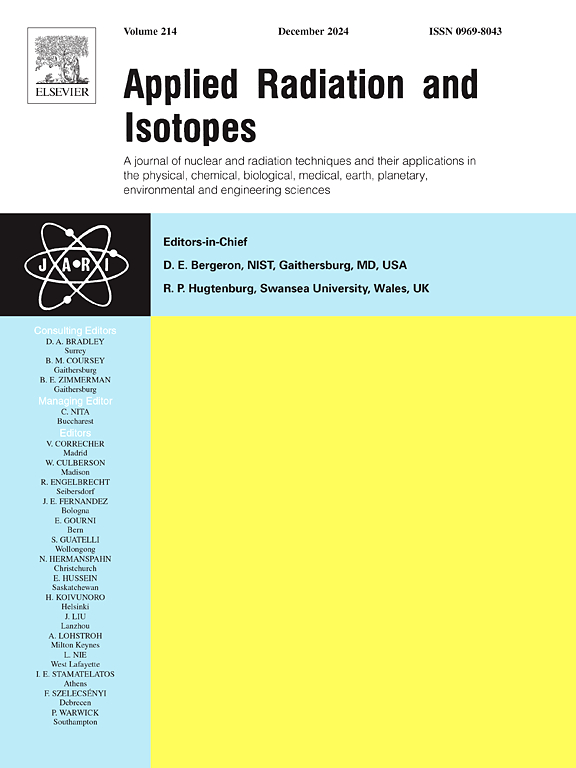Investigation into radionuclides presence and radioactivity levels in coastal sediments proximate to the Almirante Álvaro Alberto Nuclear Power Plant
IF 1.8
3区 工程技术
Q3 CHEMISTRY, INORGANIC & NUCLEAR
引用次数: 0
Abstract
The study investigated the concentrations of natural radionuclides [238U, 232Th, 40K] and artificial radionuclide [137Cs] in sediment samples from eight sites in Piraquara de Fora, Angra dos Reis, Brazil, utilizing gamma-ray spectrometry with high-purity germanium [HPGe] detector from Canberra, carefully calibrated for both energy and efficiency. The mean activity concentrations of U, 232Th, 40K and 137Cs in the coastal sediment samples were 16 4 Bq.kg, 20 3 Bq.kg, 476 67 Bq.kg, MDA, respectively. Furthermore, radiological risk parameters, including the absorbed dose rate, annual effective dose, external and internal hazard indices, excess lifetime cancer risk, and gamma index, were calculated for the sediment samples from Piraquara de Fora. The mean values obtained were within recommended safety limits, indicating that long-term radiation exposure to the local population along Piraquara de Fora does not present a significant health risk from a radiological standpoint.
阿尔米兰特Álvaro阿尔贝托核电厂附近海岸沉积物中放射性核素存在和放射性水平的调查
该研究利用来自堪培拉的高纯度锗(HPGe)探测器的伽马射线能谱法,对巴西安格拉多斯Reis Piraquara de Fora 8个地点沉积物样品中的天然放射性核素[238U, 232Th, 40K]和人工放射性核素[137Cs]的浓度进行了研究,并对能量和效率进行了仔细校准。沿海沉积物样品中238U、232Th、40K和137Cs的平均活度浓度为16±4 Bq。kg−1,20±3bq。kg−1,476±67 Bq。kg−1,<;MDA。此外,计算了Piraquara de Fora沉积物样品的辐射风险参数,包括吸收剂量率、年有效剂量、外部和内部危害指数、过量终身癌症风险和伽马指数。所获得的平均值在建议的安全限制范围内,表明从放射学角度来看,对Piraquara de Fora沿线当地人口的长期辐射照射不会造成重大的健康风险。
本文章由计算机程序翻译,如有差异,请以英文原文为准。
求助全文
约1分钟内获得全文
求助全文
来源期刊

Applied Radiation and Isotopes
工程技术-核科学技术
CiteScore
3.00
自引率
12.50%
发文量
406
审稿时长
13.5 months
期刊介绍:
Applied Radiation and Isotopes provides a high quality medium for the publication of substantial, original and scientific and technological papers on the development and peaceful application of nuclear, radiation and radionuclide techniques in chemistry, physics, biochemistry, biology, medicine, security, engineering and in the earth, planetary and environmental sciences, all including dosimetry. Nuclear techniques are defined in the broadest sense and both experimental and theoretical papers are welcome. They include the development and use of α- and β-particles, X-rays and γ-rays, neutrons and other nuclear particles and radiations from all sources, including radionuclides, synchrotron sources, cyclotrons and reactors and from the natural environment.
The journal aims to publish papers with significance to an international audience, containing substantial novelty and scientific impact. The Editors reserve the rights to reject, with or without external review, papers that do not meet these criteria.
Papers dealing with radiation processing, i.e., where radiation is used to bring about a biological, chemical or physical change in a material, should be directed to our sister journal Radiation Physics and Chemistry.
 求助内容:
求助内容: 应助结果提醒方式:
应助结果提醒方式:


